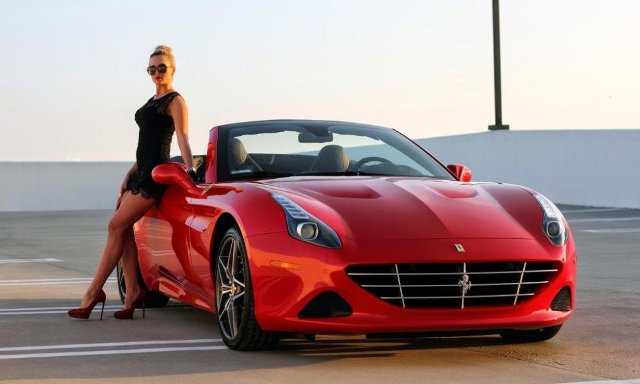Ferrari California, Versatile Front Engined 2+2 with V-8 Power
Ferrari California: Ferrari expands model range to include a V-8 powered front-engined 2+2. The newcomer is up to the minute with the latest technology, including a seven-speed dual-clutch sequential gearbox.
Another superb car from Ferrari, which is a little overweight, despite the aluminum frame. Even so, the California reaches 60 mph in under 4 seconds, and can go on to 192 mph.
In the Ferrari mold
Easily recognizable as a Ferrari, the California has the svelte lines one expects from the combination of Ferrari and Pininfarina, starting with the distinctive grille and air intake on the hood and swept back headlamps.
There are a pair of small air intakes at the sides of the main grille, and then there is the classic Ferrari shape for its front-engined cars. This one is a little different, though, with scalloped flanks, with an extra line running from the front wheel arch up and over the rear wheel arch. This conceals the rather higher tail than normal needed to provide space for the retractable metal roof.
Circular LED rear lamps
The rear is not quite typical Ferrari, although it does have circular LED rear lamps as on other models, and an integral spoiler. There is a wide diffuser at the bottom, which ensures download and low drag, with pairs of exhaust pipes coming out at each side – one above the other, which does not look so good.
Overall, this is a fine body, with a Cd of just 0.32, and good down lift. Inside, the car can be configured as a two-seater with bench behind, or as a proper 2+2 with two rear seats.
New direct injection V-8
The heart of the California is a new 4.3 liter V-8 from Ferrari, the first of its engines to have direct injection, which improves power and fuel economy. It has an aluminum cylinder block and heads, and a crankshaft with the pins arranged at 180 degrees – a flat-plane crank.
Emissions are reduced thanks to variable valve timing, which also ensures a good compromise between maximum power and good fuel economy.
This new engine develops 460 bhp at 7,750 rpm, compared with 483 bhp at 8,500 rpm in the F430, the slightly lower power output being more suitable for the heavier 2+2. Maximum torque is 357 lb ft (485 Nm) at 5,000 rpm.
Dual-clutch sequential gearbox
To get the most out of the car, Ferrari is using its first dual-clutch gearbox, pioneered by VW, but in this instance with seven speeds. This arrangement allows full power shifts, which can be made faster than with Ferrari's other electronically controlled boxes. It can also give very smooth shifts, and helps improve fuel economy. Traditionalists can have a manual six-speed box.
As on the larger Ferraris, the gearbox is mounted at the rear, in conjunction with the axle gears, this improving weight distribution by getting more weight over the rear wheels. In fact, weight distribution is 47:53 per cent front:rear, compared with 46:54 to 49:51 for supercars with front-mounted gearboxes.
Aluminum frame with wishbone suspension
Like other Ferraris, the California has a lightweight aluminum frame consisting of extrusions and castings, while the panels are also aluminum.
At the front, classic double wishbones are used, while at the rear, a multi-link version of double wishbones is used to give compliance and good wheel control.
Magneto dampers are available as an option, as ion the F599 GTB. These respond immediately to the conditions to stiffen or soften damping as needed.
Carbon-ceramic discs
Carbon-ceramic brake discs are used all round, those at the front being 15.3-inch (390 mm) diameter, and at the rear 14.2-inch (360 mm) diameter – these are big brakes. Of course, ABS is standard, as are other electronic controls including traction control and stability control.
These are controlled through the manettino mounted on the steering wheel. The driver can select Comfort or Sport of CST off, which leaves just the ABS functioning. The manettino controls not just the stability and traction controls, but also engine settings.As standard, 19-inch wheels are used, with 245/40ZR front and 285/40ZR rear tires.
Although the Ferrari California looks compact, it is actually quite large, being almost as long as the F599GTB. It is also surprisingly heavy, weighing in at 3,821 lb (1,735 kg). This compares unfavourably with the longer Jaguar XKR at 3,671 lb, and the Aston Martin V-8 Vantage at 3,595 lb. The retractable roof accounts for some of this extra weight, but even so, the California is disappointingly heavy.

Comments
Post a Comment